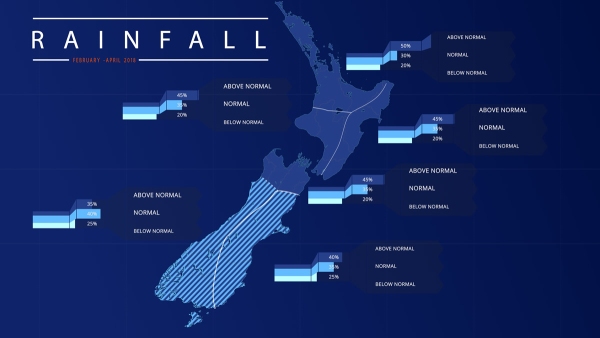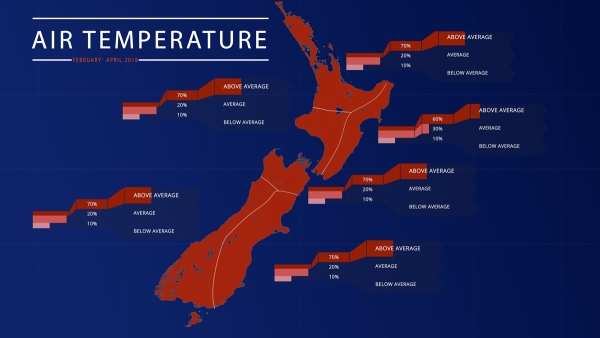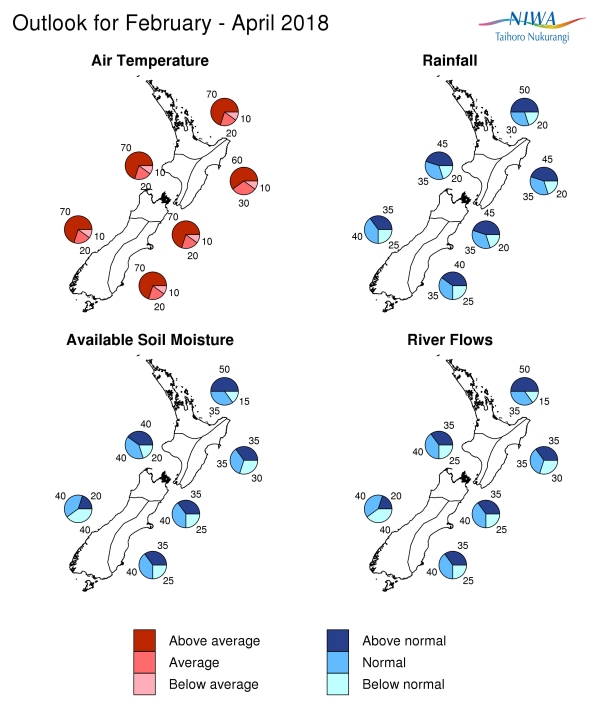Overview
Weak La Niña conditions continued in the tropical Pacific during January 2018. Below average sea surface temperatures (SSTs) remained present in the central and eastern equatorial Pacific Ocean but warmed slightly compared to December 2017. Subsurface ocean waters also warmed during January but remained broadly consistent with weak La Niña conditions. After decreasing during December 2017, trade winds again increased in the central and western equatorial Pacific Ocean during January. Consequently, the Southern Oscillation Index (SOI) reverted to positive values like those experienced in October and November and was also consistent with the persistence of weak La Niña conditions.
The consensus from international models is that weak La Niña conditions (50% chance) are as likely as ENSO neutral conditions (50% chance) over the next 3 months (February – April 2018). The chance for ENSO neutral conditions then increases during the May – July 2018 period (65% chance). Overall, this suggests that a continued decay of La Niña conditions is expected over the next three months.
Apart from waning La Niña conditions, New Zealand’s regional climate over the next three month period is expected to be dominated by the very warm ocean waters (so called “marine heatwave”) present around the country, in the Tasman Sea, and in the Southwest Pacific Ocean.
For February – April 2018, the atmospheric circulation around New Zealand is forecast to be characterized by higher pressures than normal east and south of the country, while lower pressure than normal is forecast over the Tasman Sea, extending over the North Island. This pressure pattern, in concert with the marine heatwave, is expected to be associated with warmer than average air temperatures, occasional significant rainfall events, and flow anomalies from the northeasterly quarter.
For the current tropical cyclone season (November 2017 to April 2018), NIWA's Southwest Pacific Tropical Cyclone Outlook indicates that the risk for New Zealand is normal or above normal.
On average, at least one ex-tropical cyclone passes within 550km of New Zealand each year. If an ex-tropical cyclone comes close to the country, it has equal probability of passing east or west of Auckland and the North Island. Significant rainfall, damaging winds and coastal damage can occur leading up to and during these events.
During the first few days of the forecast period, ex-Tropical Cyclone Fehi will impact New Zealand, especially the South Island.
Outlook Summary
February – April 2018 temperatures are forecast to be above average for all regions of New Zealand with high confidence (60 to 70% chance).
For February – April 2018, rainfall totals are forecast to be above normal in the North Island and in the north of the South Island (45 to 50% chance) and about equally likely to be near normal (35 to 40% chance) or above normal (35 to 40% chance) in the west and east of the South Island.
February – April 2018 soil moisture levels and river flows are forecast to be above normal (50% chance) in the north of the North Island, equally likely to be normal (40% chance) or below normal (40% chance) in the west of the South Island, and about equally likely to be normal (35 to 40% chance) or above normal (35 to 40% chance) for all remaining regions of New Zealand.
Regional predictions for the February – April 2018 season
Northland, Auckland, Waikato, Bay of Plenty
The table below shows the probabilities (or percent chances) for each of three categories: above average, near average, and below average. In the absence of any forecast guidance there would be an equal likelihood (33% chance) of the outcome being in any one of the three categories. Forecast information from local and global guidance models is used to indicate the deviation from equal chance expected for the coming three-month period, with the following outcomes the most likely (but not certain) for this region:
- Temperatures are very likely to be above average (70% chance).
- Rainfall totals are most likely to be in the above normal range (50% chance).
- Soil moisture levels and river flows are most likely to be in the above normal range (50% chance).
The full probability breakdown is:
|
Temperature |
Rainfall |
Soil moisture |
River flows |
|
|
Above average |
70 |
50 |
50 |
50 |
|
Near average |
20 |
30 |
35 |
35 |
|
Below average |
10 |
20 |
15 |
15 |
Central North Island, Taranaki, Whanganui, Manawatu, Wellington
Probabilities are assigned in three categories: above average, near average, and below average.
- Temperatures are very likely to be above average (70% chance).
- Rainfall totals are most likely to be above normal (45% chance).
- Soil moisture levels and river flows are about equally likely to be in the above normal range (35 to 40% chance) or near normal range (35 to 40% chance).
The full probability breakdown is:
|
Temperature |
Rainfall |
Soil moisture |
River flows |
|
|
Above average |
70 |
45 |
40 |
35 |
|
Near average |
20 |
35 |
40 |
40 |
|
Below average |
10 |
20 |
20 |
25 |
Gisborne, Hawke’s Bay, Wairarapa
Probabilities are assigned in three categories: above average, near average, and below average.
- Temperatures are very likely to be above average (60% chance).
- Rainfall totals are most likely to above normal (45% chance).
- Soil moisture levels and river flows are equally likely to be in the above normal range (35% chance) or near normal range (35% chance).
The full probability breakdown is:
|
Temperature |
Rainfall |
Soil moisture |
River flows |
|
|
Above average |
60 |
45 |
35 |
35 |
|
Near average |
30 |
35 |
35 |
35 |
|
Below average |
10 |
20 |
30 |
30 |
Tasman, Nelson, Marlborough, Buller
Probabilities are assigned in three categories: above average, near average, and below average.
- Temperatures are very likely to be above average (70% chance).
- Rainfall totals are most likely to above normal (45% chance).
- Soil moisture levels and river flows are about equally likely to be in the near normal range (40% chance) or above normal range (35% chance).
The full probability breakdown is:
|
Temperature |
Rainfall |
Soil moisture |
River flows |
|
|
Above average |
70 |
45 |
35 |
35 |
|
Near average |
20 |
35 |
40 |
40 |
|
Below average |
10 |
20 |
25 |
25 |
West Coast, Alps and foothills, inland Otago, Southland
Probabilities are assigned in three categories: above average, near average, and below average.
- Temperatures are very likely to be above average (70% chance).
- Rainfall totals are about equally likely to be near normal (40% chance) or above normal (35% chance).
- Soil moisture levels and river flows are equally likely to be in the near normal range (40% chance) or below normal range (40% chance).
The full probability breakdown is:
|
Temperature |
Rainfall |
Soil moisture |
River flows |
|
|
Above average |
70 |
35 |
20 |
20 |
|
Near average |
20 |
40 |
40 |
40 |
|
Below average |
10 |
25 |
40 |
40 |
Coastal Canterbury, east Otago
Probabilities are assigned in three categories: above average, near average, and below average.
- Temperatures are very likely to be above average (70% chance).
- Rainfall totals are about equally likely to be in the above normal range (40% chance) or near normal range (35% chance).
- Soil moisture levels are about equally likely to be near normal (40% chance) or above normal (35% chance).
- River flows are about equally likely to be in the near normal range (40% chance) or above normal range (35% chance).
The full probability breakdown is:
|
Temperature |
Rainfall |
Soil moisture |
River flows |
|
|
Above average |
70 |
40 |
35 |
35 |
|
Near average |
20 |
35 |
40 |
40 |
|
Below average |
10 |
25 |
25 |
25 |
Graphical representation of the regional probabilities
Background
Weak La Niña conditions persisted in the tropical Pacific during January 2018. Sea surface temperatures (SSTs) in the central and eastern equatorial Pacific Ocean warmed somewhat during January 2018; however, below average SSTs remained present. The NINO1 index (near the coast of Peru), which was the most negative with a value below -1.0oC for December 2017, weakened to -0.52oC during January 2018. The NINO3.4 index is negative at -0.68oC (and therefore in the La Niña category), the NINO3 index is at -0.91oC and the NINO4 index is only very weakly negative (-0.13 oC for the month of January 2018 as a whole).
Cooler than normal subsurface ocean waters (within the first 150 meters of the ocean) in the central and eastern equatorial Pacific (east of about 150°W) persisted during the month of January 2018 but warmed slightly compared to December 2017. Spatially, the -1 to -2oC anomaly that existed during December has shrunk and is confined to the far eastern Pacific. The positive subsurface temperature anomalies present in the western Pacific Ocean (west of ~ 150oW and at about 150m deep) have continued to expand eastward, although the maximum anomaly is now approximately +2oC, weaker than last month. The upper ocean (first 300 meters) heat content anomalies are now slightly positive between 160oW and 125oW, consistent with a gradual decay of La Niña conditions from west to east.
While the ocean-atmosphere system remained consistent with a weak La Niña state during January 2018, some oceanic indicators, such as the upper ocean heat content and related SST values, decayed. Meanwhile, the Southern Oscillation Index (SOI) increased into the La Niña range once again (+1.0 for January 2018 as a whole) after having subsided to neutral during December 2017. Similarly, the negative zonal wind anomalies that were present in November in the western Pacific Ocean, signalling enhanced trade wind circulation, returned during January.
Rainfall and convection anomalies remained consistent with La Niña conditions in the central and eastern Pacific, where reduced convection and rainfall is present along the Equator. The ENSO Precipitation Index (ESPI) remained negative (i.e. indicative of La Niña) during January 2018, with a value of -1.05 (last 30 days to the 30th of January 2018).
In summary, weak La Niña conditions remain present in the Pacific Ocean, despite weakened oceanic signals during January 2018. The international consensus is that La Niña conditions are now equally likely to persist (50% chance) or decay to ENSO-neutral (50% chance) over the next 3 month period (February – April 2018). The chance for ENSO neutral conditions then increases to 65% during the May – July 2018 period.
Coastal waters remain much warmer than average all around New Zealand, in the Tasman Sea, and in the Southwest Pacific with anomalies currently exceeding +2.0oC for all coastal areas around the country. Toward the end of January 2018, the so called “marine heatwave” reached a secondary anomalous peak (the first peak occurred in early December).
According to the dynamical models’ forecasts, significantly warmer than average SSTs are likely to persist for at least part of the next 3 months (February – April 2018), although the anomalies are expected to ease off slightly over the same period.
Contact
Chris Brandolino, Principal Scientist – Forecasting, NIWA National Climate Centre Tel (09) 375 6335, Mobile (027) 886 0014
Dr Brett Mullan, Principal Scientist, NIWA National Climate Centre Tel (04) 386 0508, Mobile (027) 294 1169
Notes to reporters and editors
- NIWA’s outlooks indicate the likelihood of climate conditions being at, above, or below average for the season as a whole. They are not ‘weather forecasts’. It is not possible to forecast precise weather conditions three months ahead of time.
- The outlooks are the result of the expert judgment of NIWA’s climate scientists. They take into account observations of atmospheric and ocean conditions and output from global and local climate models. The presence of El Niño or La Niña conditions and the sea surface temperatures around New Zealand can be a useful indicator of likely overall climate conditions for a season.
- The outlooks state the probability for above average conditions, near average conditions, and below average conditions for rainfall, temperature, soil moisture, and river flows. For example, for winter (June–July–August) 2007, for all the North Island, we assigned the following probabilities for temperature: · Above average: 60 per cent · Near average: 30 per cent · Below average: 10 per cent We therefore concluded that above average temperatures were very likely.
- This three-way probability means that a random choice would be correct only 33 per cent (or one-third) of the time. It would be like randomly throwing a dart at a board divided into three equal parts, or throwing a dice with three numbers on it. An analogy with coin tossing (a two-way probability) is not correct.
- A 50 per cent ‘hit rate’ is substantially better than guesswork, and comparable with the skill level of the best overseas climate outlooks. See, for example, analysis of global outlooks issued by the International Research Institute for Climate and Society based in the US published in the Bulletin of the American Meteorological Society (Goddard, L., A. G. Barnston, and S. J. Mason, 2003: Evaluation of the IRI’s “net assessment” seasonal climate forecasts 1997–2001. Bull. Amer. Meteor. Soc., 84, 1761–1781).
- Each month, NIWA publishes an analysis of how well its outlooks perform. This is available online and is sent to about 3500 recipients of NIWA’s newsletters, including many farmers.
- All outlooks are for the three months as a whole. There will inevitably be wet and dry days, and hot and cold days, within a season. The exact range in temperature and rainfall within each of the three categories varies with location and season. However, as a guide, the “near average” or middle category for the temperature predictions includes deviations up to ±0.5°C for the long-term mean, whereas for rainfall the “near normal” category lies between approximately 80 per cent and 115 per cent of the long-term mean.
- The seasonal climate outlooks are an output of a scientific research programme, supplemented by NIWA’s Capability Funding. NIWA does not have a government contract to produce these outlooks.
- Where probabilities are within 5% of one another, the term “about equally” is used.



